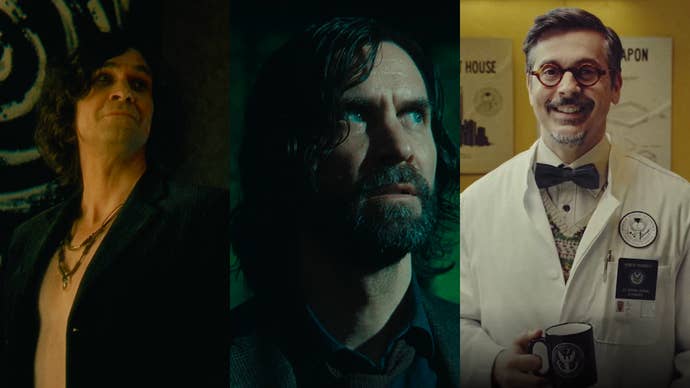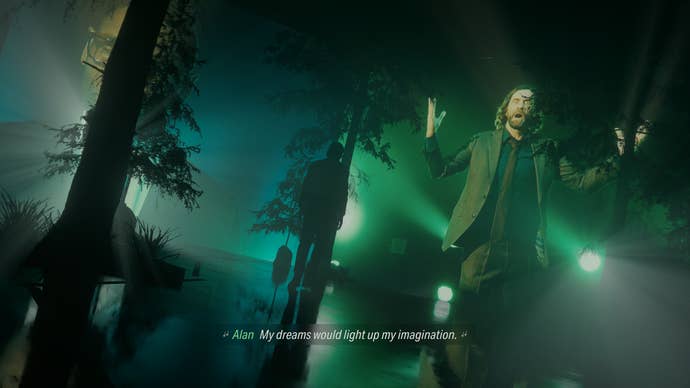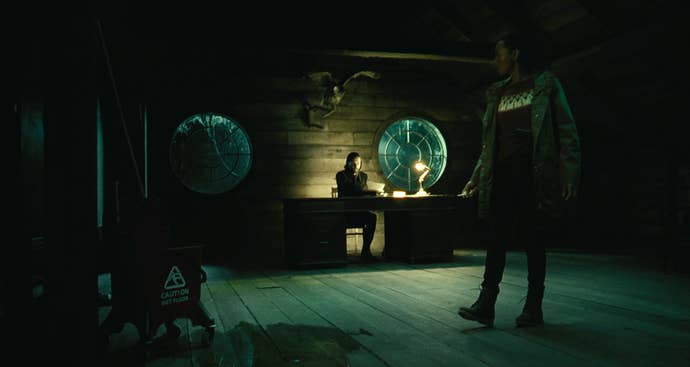Remedy’s Sam Lake: “Find somebody who makes you better and gives you energy”

At Develop:Brighton last week, Remedy’s Sam Lake reflected on three decades of game development, sharing the inner workings of his role as one of the studio’s creative directors, why collaboration and teamwork is key, and how games are the best outlet for exploring deep, intricate narratives.
Lake joined Remedy in 1996 as a writer on Remedy’s first game, Death Rally. He was the sole writer on Max Payne and Max Payne 2 before he was joined by Mikko Rautalahti and Petri Järvilehto to write the screenplay for Alan Wake.
Lake realised “a role in directing would make a lot of sense with the experience and involvement” he had in the development of the studio’s portfolio up until that point, and it was during Alan Wake’s American Nightmare that he took on the role as director, and subsequently creative director.
Importance of collaboration
During the fireside chat, Lake shared his enthusiasm about collaborating and working with other creative minds. He noted that as a development team grows, it gets hard to work with everyone. That’s what led to him working “very closely with a core crew” where they could “work together on the vision and every aspect” of a game like Alan Wake 2.
Lake co-directed the game with Kyle Rowley, and they both worked closely with art director Janne Pulkkinen to maintain the vision of the game. They also worked with cinematic and live action director Anssi Määttä and Clay Murphy, who Lake co-wrote the game’s screenplay with.
“There is always a partner to bounce things back and forth and it makes it better,” he said.
“I felt that I was stretched so thin during the making of Alan Wake 2, but at the same time, it would have fallen apart if there had not been these dedicated partners in all the different areas. That’s a kind of partnership in my mind, finding a way to collaborate, discuss, and have that trust in a relationship.”
In it together
Maintaining these partnerships, Lake said, is a top priority during the creative process.
“In making video games and the business of it, trying to make it really efficient and all, there is always this danger that making games turns into an Excel sheet,” he explained. “When people start to become numbers to be moved around, especially in creative work, it’s really crucial and vital that people can work together.”
He noted, however, that this doesn’t always work.
“There are many really brilliantly talented people who absolutely can’t work together, even if they would want to. It just doesn’t click into place and they get in each other’s way, annoy each other, which slows things down. The best kind of a partnership is to find somebody who makes you better and gives you energy.
“In creative work, it’s really crucial and vital that people can work together”
“When you have the right kind of a partner, when you are feeling down, they are feeling up and give their energy to you. When ideas are bouncing back and forth, when you already think that this is the best version [an idea] can be, the other person has another idea and that makes you go like, ‘Yeah, yeah yeah! Wait, actually…’ and that’s what I love about the work. When you find somebody who gives you that, then you want to hold onto it.”
He added: “It can feel like a burden sometimes when you have a thing in your head and it can be a frustration when people are not getting it. But it does go back to communication. You need to be trying to actively find those partners who I was talking about earlier, to make it better, build it up.”
Matthew Porretta and Ilkka Villi
Lake highlighted how he carries this sentiment into working with actors on Remedy projects.
“I really like collaborating with people I learn to know – even to the point of bringing back the same actors and writing something specifically for them. Like knowing what they can do really well, what doesn’t quite work with them, and having that knowledge in my head when I’m writing the screenplay.”
Here he brought up long-time collaborators Matthew Porretta and Ilkka Villi, who both portray Alan Wake. Porretta voices Alan, while Villi is the character model and performs as Alan in live-action scenes, which Porretta dubs. Having worked with them for so long, Lake wanted to “give them an opportunity to be the full package”.

“They’re brilliant in their collaboration,” he added. “But that’s a big part of how Control’s Casper Darling was born, because Matt always has a twinkle in his eye and is more relaxed compared to Alan, who is more stiff as a character.
“And it was the same with Ilkka in Alan Wake 2. The character of Thomas Zane, as we find him in [the game] was almost like: ‘Let’s start with the idea of what would be the opposite of Alan’. We had improvisational sessions to find the character with Ilkka, and he brought a lot of these ideas that Zane could be more feminine and really touchy-feely, and [we] built the character out of that.”
What a Remedy game looks like
Lake explained that his approach of working with the same actors who inspire him is also how he approaches coming up with story ideas.
This naturally evolved into the concept of the Remedy connected universe, which features Alan Wake and Control. Max Payne and Quantum Break are only vaguely alluded to owing to IP ownership constraints with Rockstar and Microsoft.
The studio’s shared universe is “an echo and continuation” of certain narrative elements from its games. As to whether this prevents Remedy from making games not connected to Alan Wake or Control, Lake said it actually “gives you a lot of material to play around with”.
Detailed lore, callbacks, and internal references are what makes a Remedy game… a Remedy game.
“[Alan Wake] is tailor-made to bring in different mediums and art into the mix”
Lake boiled it down to utilising different mediums to tell a complex story. “Going all the way back to Max Payne, the motivation was how can we, within the limits that we have, make a proper, deeper story in the context of an action game?”
This was achieved by creating a graphic novel with voiceovers, as technical limitations at the time meant cutscenes lacked emotional depth. Lake noted that this use of a different artform within a game was the catalyst for experimenting with others in future titles, with Alan Wake being the culmination of this idea.
“The lore [of Alan Wake] is about art in different forms, changing or shaping reality. In some ways, it’s tailor-made to bring different mediums and art into the mix.”
Lake emphasised that there always has to be a motivation to bring, say, a musical sequence into the fold – an idea that has been on his backburner since Control, and only just made the cut for Alan Wake 2.
Navigating disappointment
Lake recalled that not being able to get that musical moment in Control was disappointing, but he tried not to dwell on it.
“In an interesting way, often these disappointments and frustrations of not being able to do a certain thing… it’s never lost,” he explained. “And this is me as a creative director, comforting the team who are often very disappointed about these things. But look, this idea isn’t going anywhere. In fact, it might be that it finds a much better home somewhere along the way.”
Case in point: the troubled history of making Alan Wake 2, which was stuck in development hell for 13 years.
“The frustration of years and years and years of trying to make Alan Wake 2 happen and it not happening, being really frustrated and disappointed every time we tried and failed. But, I’m so happy those versions didn’t end up being Alan Wake 2 because they were so far from what we were able to do now.”
Lake said that ruminating on what can’t and doesn’t happen can lead to the team getting stuck “in a negative loop”.

“It starts to drag the whole team down. Based on experience, whenever we run into an obstacle where something that we had planned is not working […] it’s an opportunity to make what we are making better. We can go in, rethink, and come up with a new plan and make it better than the old one.”
This circled back to the importance Lake puts on team communication, in understanding why things can or can’t work and how to approach these issues with a level head.
“When you’re collaborating with people who don’t get [an idea] or have an opposing viewpoint, it’s crucial that you keep explaining your view so they can understand. And the flip side is asking questions, because people can very easily say: ‘No, we can’t do that’. That’s a really bad way of communicating. Because if you don’t understand why something can’t be done, it feels like the other person is absurd or unreasonable (even if they have a really good reason) and you’ll be angry and frustrated.”
“When you understand [something doesn’t work], suddenly it’s much easier to accept, but it’s also easier to understand how to get around it.”
Using different mediums
Overcoming these obstacles was crucial during the development of Alan Wake 2, which featured a lot of experimentation.
Referring to the current issues surrounding artificial intelligence, Lake said Remedy “very purposefully” utilised practical effects for Alan Wake 2’s live-action elements to highlight the importance of “old fashioned” techniques.
For example, the team physically built 1:1 sets of the game environments for filming live-action scenes. They also created special effects which could have easily been done digitally, with Lake highlighting that the vortex used when players switch between characters was produced by mounting a slow motion camera on top of a blender.
“It’s insane to do physical stuff when it’s a game that’s fully digital to begin with, but the same goes with actors – having great, wonderful actors do the performances, it brings so much emotion and believability into the whole world.”

Lake said that by bringing in actors, musicians, and artists to collaborate with the development team, they could create something truly unique.
“I’m a fan of all these different art forms. I’m a total amateur in everything, hence bringing in collaborators. But I feel that my mission as a creative director and maker of games is to explore and find new ways of bringing these [different mediums] in.”
“On top of that, we have the interactivity which makes a game a game. It brings the player in and makes them a part of piecing it all together and experiencing it. I really believe that games as a storytelling medium are, if not already, in the process of becoming the most advanced form of storytelling humans have come up with because of how much there can be in terms of worldbuilding and storytelling. How deep can you go as a player into this experience?”
Not being held back by one genre
In addition to creating deep, multi-layered games, Lake appreciated how the medium lets developers explore a variety of genres when creating a story.
“There is no rule set. We can experiment, bring in different things. Maybe they aren’t always successful, but that will usually spark a new thought to take further. You should always find your own voice in that, find what excites you, then try to find a way of using that as part of a game.”
Lake said that “being able to hop around and do our version” of different genres made him realise that “when something is really ambitious, it’s usually not a genre thing […] it’s playing around with genre conventions”.
“If you look at Alan Wake 2, we have our police procedural, we have our psychological, very Lynchian horror thing, action-y, supernatural, all-out comedy, musicals – all of these elements. Having that flow through keeps it fresh and keeps everybody engaged and more aware.”
Embracing Finnish culture
Aside from genre, Lake realised that as he has “grown old and become more nostalgic,” he’s understood the benefit of implementing aspects of the studio’s Finnish culture into its games.
“We tend to be inspired by well-established things and that’s fine and important, but we should be looking closer to home and drawing [ideas] from that,” he said.
“We all come from different countries, we all have our own cultures and mythologies. I think there is a treasure there because even if we feel certain things are a total cliché and the audience in our own country have seen it a lot, globally in many cases that’s never been seen before.”
For example, in Alan Wake 2 there is the 20-minute Finnish short film Yötön Yö (Nightless Night), which has an accompanying, original song also performed in Finnish. Lake pointed out that looking at the game’s data, a quarter of a million players have watched the entire film, which is completely optional (and missable).
“Given today’s market where competition is so fierce, you need to have elements that stand out and are different,” Lake added. “I will be putting more Finnish stuff into our games for sure, until someone tells me it’s too much and then I will take a step back. But not before.”
Looking back
Reflecting on three decades of work is a big ask, but Lake emphasised that he’s proud of every game and achievement since Remedy’s inception.
“It really is the overall journey, because I do feel that all the ideas are informed by what came before,” he said. “A question that is often asked is: ‘If you could go back and say some advice to a younger version of you’ – it doesn’t make any sense to me because I wouldn’t be me if I had been given another path at that point.”
“All of those things that interest me and I’m wanting to put in [games] are because of everything that has happened to this point.”
Which is why he is most proud of producing Alan Wake 2. “It was a very personal project, and I did throw myself into it to an unreasonable degree. I wanted to be involved in all these different areas, which I bet was frustrating to some of the production realities.
“But at the same time, I’m so very proud of what we were able to do with it and achieve.”












